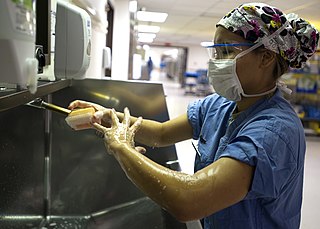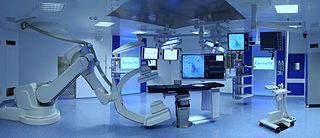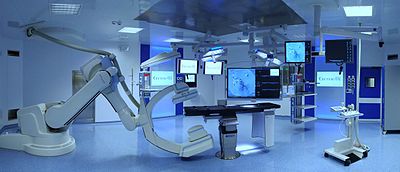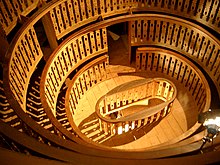
Surgery is a medical specialty that uses manual and instrumental techniques to diagnose or treat pathological conditions, to alter bodily functions, to reconstruct or improve aesthetics and appearance, or to remove unwanted tissues or foreign bodies. The subject receiving the surgery is typically a person, but can also be a non-human animal.

The Ether Dome is a surgical operating amphitheater in the Bulfinch Building at Massachusetts General Hospital in Boston, United States. It served as the hospital's operating room from its opening in 1821 until 1867. It was the site of the first public demonstration of the use of inhaled ether as a surgical anesthetic on October 16, 1846, otherwise known as Ether Day. Crawford Long, a surgeon in Georgia, had previously administered sulfuric ether in 1842, but this went unpublished until 1849. The Ether Dome event occurred when William Thomas Green Morton, a local dentist, used ether to anesthetize Edward Gilbert Abbott. John Collins Warren, the first dean of Harvard Medical School, then painlessly removed part of a tumor from Abbott's neck. After Warren had finished, and Abbott regained consciousness, Warren asked the patient how he felt. Reportedly, Abbott said, "Feels as if my neck's been scratched". Warren then turned to his medical audience and uttered "Gentlemen, this is no Humbug". This was presumably a reference to the unsuccessful demonstration of nitrous oxide anesthesia by Horace Wells in the same theater the previous year, which was ended by cries of "Humbug!" after the patient groaned with pain.

Eye surgery, also known as ophthalmic surgery or ocular surgery, is surgery performed on the eye or its adnexa. Eye surgery is part of ophthalmology and is performed by an ophthalmologist or eye surgeon. The eye is a fragile organ, and requires due care before, during, and after a surgical procedure to minimize or prevent further damage. An eye surgeon is responsible for selecting the appropriate surgical procedure for the patient, and for taking the necessary safety precautions. Mentions of eye surgery can be found in several ancient texts dating back as early as 1800 BC, with cataract treatment starting in the fifth century BC. It continues to be a widely practiced class of surgery, with various techniques having been developed for treating eye problems.

A surgical technologist, also called a scrub, scrub tech, surgical technician, or operating department practitioner or operating room technician, is an allied health professional working as a part of the team delivering surgical care. Surgical technologists are members of the surgical team. The members of the team include the surgeon, surgeon's assistant, circulator nurse and anesthesia provider. They possess knowledge and skills in sterile and aseptic techniques. There are few mandatory professional requirements for surgical technologists, and the scope of practice varies widely across countries and jurisdictions. Surgical technologists attend junior colleges and technical schools, and many are trained in military schools. In the military they perform the duties of both the circulator and the scrub. The goal is for surgical technologists to be able to anticipate the next move the surgeon is going to make in order to make the procedure as smooth and efficient as possible. They do this by having knowledge of hundreds of surgical procedures and the steps the surgeon needs to take in order to complete the procedure, including the very wide range of surgical instruments they may need. Specialties can include, but are not limited to, the following: genitourinary, obstetrics and gynaecology, urology, ENT, plastics, general, orthopedics, neurology, and cardiovascular. They only work in surgical or perioperative areas and are highly specialized. Surgical technologist is the proper term for a two-year program which earns a degree in applied sciences. The profession is up and coming and highly in demand.
The Lifeline Express, or Jeevan Rekha Express, is a hospital train in India that has been running since 16 July 1991. It was a collaboration between the Impact India Foundation (IIF), Indian Railways (IR) and the Health Ministry. The train is funded by IIF, international charitable sources, Indian corporations and individuals. The train has made a health impact both in India, as well as around the world where it has inspired similar initiatives.

Asepsis is the state of being free from disease-causing micro-organisms. There are two categories of asepsis: medical and surgical. The modern day notion of asepsis is derived from the older antiseptic techniques, a shift initiated by different individuals in the 19th century who introduced practices such as the sterilizing of surgical tools and the wearing of surgical gloves during operations. The goal of asepsis is to eliminate infection, not to achieve sterility. Ideally, a surgical field is sterile, meaning it is free of all biological contaminants, not just those that can cause disease, putrefaction, or fermentation. Even in an aseptic state, a condition of sterile inflammation may develop. The term often refers to those practices used to promote or induce asepsis in an operative field of surgery or medicine to prevent infection.
Infection prevention and control is the discipline concerned with preventing healthcare-associated infections; a practical rather than academic sub-discipline of epidemiology. In Northern Europe, infection prevention and control is expanded from healthcare into a component in public health, known as "infection protection". It is an essential part of the infrastructure of health care. Infection control and hospital epidemiology are akin to public health practice, practiced within the confines of a particular health-care delivery system rather than directed at society as a whole.

Electrosurgery is the application of a high-frequency alternating polarity, electrical current to biological tissue as a means to cut, coagulate, desiccate, or fulgurate tissue. Its benefits include the ability to make precise cuts with limited blood loss. Electrosurgical devices are frequently used during surgical operations helping to prevent blood loss in hospital operating rooms or in outpatient procedures.
The perioperative period is the period of a patient's surgical procedure. It commonly includes ward admission, anesthesia, surgery, and recovery. Perioperative may refer to the three phases of surgery: preoperative, intraoperative, and postoperative, though it is a term most often used for the first and third of these only - a term which is often specifically utilized to imply 'around' the time of the surgery. The primary concern of perioperative care is to provide better conditions for patients before an operation and after an operation.
In the United Kingdom, operating department practitioners (ODPs) are allied healthcare professionals who are involved in the planning and delivery of perioperative care. As the name suggests, they are primarily employed in surgical operating departments, but they may also work directly within a variety of acute clinical settings, including pre-hospital emergency care, emergency departments, intensive care units (ICUs), endoscopy suites, interventional radiology, cardiac catheter suites, obstetric theatres and reproductive medicine.
A surgical nurse, also referred to as a theatre nurse or scrub nurse, specializes in perioperative care, providing care to patients before, during and after surgery. To become a theatre nurse, Registered Nurses or Enrolled Nurses must complete extra training. Theatre nurses can focus on different speciality areas, depending on which they are interested in.

Operating room management is the science of how to run an operating room suite. Operational operating room management focuses on maximizing operational efficiency at the facility, i.e. to maximize the number of surgical cases that can be done on a given day while minimizing the required resources and related costs. For example, what is the number of required anaesthetists or the scrub nurses that are needed next week to accommodate the expected workload or how can we minimize the cost of drugs used in the Operating Room? Strategic operating room management deals with long-term decision-making. For example, is it profitable to add two additional rooms to the existing facility? Typically, operating room management in profit-oriented health-care systems emphasizes strategic thinking whereas in countries with publicly funded health care, the focus is on operational decisions.

In health care facilities, isolation represents one of several measures that can be taken to implement in infection control: the prevention of communicable diseases from being transmitted from a patient to other patients, health care workers, and visitors, or from outsiders to a particular patient. Various forms of isolation exist, in some of which contact procedures are modified, and others in which the patient is kept away from all other people. In a system devised, and periodically revised, by the U.S. Centers for Disease Control and Prevention (CDC), various levels of patient isolation comprise application of one or more formally described "precaution".

Scrubs, or sometimes Surgical Scrubs, or Nursing Scrubs, are the sanitary clothing worn by physicians, nurses, dentists and other workers involved in patient care. Originally designed for use by surgeons and other operating room personnel, who would put them on when sterilizing themselves, or "scrubbing in", before surgery, they are now worn by many hospital personnel.

Sharp Memorial Hospital is a hospital in San Diego, California, in the United States. Opened in 1955, Sharp Memorial is Sharp HealthCare's largest hospital and the system's only designated Level II trauma center. Located in Serra Mesa, the hospital has 656 beds, including 48 for intensive-care services.
Perioperative nursing is a nursing specialty that works with patients who are having operative or other invasive procedures. Perioperative nurses work closely with surgeons, anaesthesiologists, nurse anaesthetists, surgical technologists, and nurse practitioners. They perform preoperative, intraoperative, and postoperative care primarily in the operating theatre.

A hybrid operating room is a very advanced surgical theatre that is equipped with advanced medical imaging devices such as fixed C-Arms, X-ray tomography (CT) scanners or magnetic resonance imaging (MRI) scanners. These imaging devices enable minimally-invasive surgery. Minimally-invasive surgery is intended to be less traumatic for the patient and minimize incisions on the patient and perform surgery procedure through one or several small cuts.

The central sterile services department (CSSD), also called sterile processing department (SPD), sterile processing, central supply department (CSD), or central supply, is an integrated place in hospitals and other health care facilities that performs sterilization and other actions on medical devices, equipment and consumables; for subsequent use by health workers in the operating theatre of the hospital and also for other aseptic procedures, e.g. catheterization, wound stitching and bandaging in a medical, surgical, maternity or paediatric ward.
Surgical humidification is the conditioning of insufflation gas with water vapour (humidity) and heat during surgery. Surgical humidification is used to reduce the risk of tissue drying and evaporative cooling.

Coblation tonsillectomy is a surgical procedure in which the patient's tonsils are removed by destroying the surrounding tissues that attach them to the pharynx. It was first implemented in 2001. The word coblation is short for ‘controlled ablation’, which means a controlled procedure used to destroy soft tissue.




















